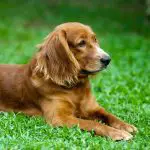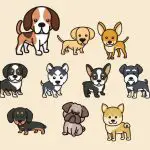Italian greyhound puppy and dog information
The Italian Greyhound is meant for a quiet apartment or home. She does not do well with loud, rough children as her bones can be brittle as a puppy and she is delicate in both body and mind. She is a good watch dog and loves her family. She can do well with other respectful dogs and animals, especially if she is socialized with them at an early age. If she is housed with other dogs, be aware that they should not be large dogs. She is a climber and may even climb out of a fenced enclosure. Keep her controlled when outside as she can run very fast and can be about impossible to catch if she does not want to be.
*Approximate Adult Size. The approximate adult size (two years old or older) of the Italian Greyhound is 12 to 15 inches to the withers (highest point of the shoulder) and 6 to 10 pounds. There is a under 8 pound class and an over 8 pound class.
*Special Health Considerations. Most dog breeds have certain inherited health problems associated with that specific breed and the Italian Greyhound is no exception. Although they are a healthy breed, be on the look out for Progressive Retinal Atrophy (inherited disease of the retina that can cause vision loss and blindness), slipped stifle and epilepsy (common in dogs). Additionally, Italian Greyhound puppies under eighteen months old are prone to broken legs due to fragile developing bones. This disease list is an informative guideline only. Other diseases may also be significant threats, please contact your veterinarian for a complete list.
She should visit the veterinarian several times in the first year for shots, boosters and check up. Then, as an adult, she should visit the veterinarian yearly for shots and check up. As she gets older, six years and on, she should visit the veterinarian twice a year for check ups and shots. Remember; avoid feeding your dog sweets.
*Grooming. The Italian Greyhound has a short, fine coat that is like satin to the touch. She just needs an occasional rub down with a soft cloth. When she needs a rare bath, be sure that she is dried properly and kept warm.
Her teeth should be brushed at least twice a week with toothpaste and toothbrush designed for dogs. Brushing removes the accumulation of plaque and tartar which can cause cavities (rarely) and periodontal disease. Dog periodontal disease can lead to pain, loss of teeth, bad breath and other serious disease.
Her toenails may need to be examined for growth and clipped regularly. The toenails of the rear feet grow slower than the toenails of the front feet. Generally a guillotine type trimmer is the best for this chore and competent instructions to accomplish this can be found on the net.
*Life Span. The Italian Greyhound can live between 14 and 16 years with proper nutrition, medical care and excellent living conditions.
*History. The Italian Greyhound comes from Italy. They are a small sight hound and were bred as pets. They were first registered by the American Kennel Association in 1886.
Some Registries: *Italian Greyhound Club of America *UKC United Kennel Club *NKC National Kennel Club *CKC Continental Kennel Club *APRI Americas Pet Registry Inc. *AKC American Kennel Club *FCI Federation Cynologique Internationale *NZKC New Zealand Kennel Club *KCGB = Kennel Club of Great Britain *ANKC = Australian National Kennel Club *ACR = American Canine Registry
Litter Size: 3 to 5 Italian Greyhound puppies.
Category: Toy
*SPECIAL GOOD POINTS They barely shed. Not a spoiled brat. Generally has good manners. Good watch dog.
*SPECIAL BAD POINTS Can be a chore to housebreak. Can be destructive, especially if left alone. Does not like criticism. Does not like it cold. Poor guard dog.
*Other Names Known By: Piccolo Levrieri Italiani
*Every dog is an individual so not everything in this information may be correct for your dog. This information is meant as a good faith guideline only.


